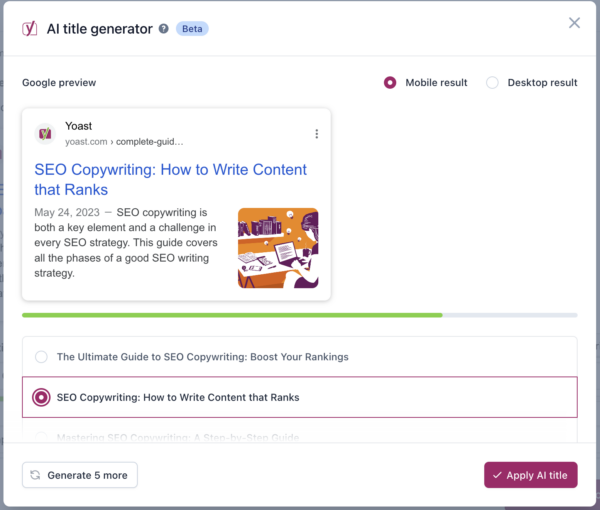Perfect prompts: 10 tips for AI-driven SEO content creation

The art of content creation has become increasingly sophisticated. The key to standing out is producing high-quality content. You should craft it precisely, making it both engaging for readers and friendly to search engines. This is where AI-powered content generation tools like ChatGPT, Bing CoPilot, and Google Gemini come in, offering efficiency and creativity. However, the true power of these tools lies not in their ability to generate content but in how we, as SEO content writers, instruct and refine their output.
Tip 1: Crafting the perfect SEO-driven prompt
Define your content goal: is it to inform, persuade, sell, or explain? Understand your audience’s needs and search habits to tailor your prompt effectively.
Choose a primary keyword that encapsulates your content’s essence and guides its direction. Then, break down the keyword to address search intent. List subtopics that delve into different aspects of your main theme, incorporating related secondary keywords.
Combine all these elements into a concise prompt. For example: “Create a detailed guide on primary keyword, covering subtopics, for target audience, integrating secondary keywords. Ensure the tone is desired tone, suitable for content type.”
Ensure clarity in your prompt to effectively align AI-generated content with your SEO objectives. This transforms your prompt into a strategic blueprint for SEO-optimized content tailored to your goals and audience.
Example prompt:
"Generate a detailed guide focused on 'Maximizing Small Kitchen Spaces.' Incorporate primary keyword 'small kitchen organization' within the introduction, headings, and conclusion. Cover subtopics including 'Creative Storage Solutions,' 'Decluttering Strategies,' and 'Multipurpose Furniture Ideas,' integrating secondary keywords 'space-saving kitchen gadgets,' 'decluttering tips for kitchens,' and 'multipurpose furniture for small spaces.' Target audience: urban apartment dwellers. Tone: Informative yet engaging."
Did you know?

Learn about generative AI and SEO at Yoast SEO Academy
Want to learn how to adapt SEO content strategies for AI? Looking to gain a competitive advantage by integrating AI tools? Check out our training course on AI for SEO!
Tip 2: Keyword optimization beyond the basics
Specify keyword placement for the AI, requesting inclusion in the introduction, subheadings, and conclusion to kickstart SEO-friendly content creation. Emphasize the natural integration of primary and secondary keywords throughout the text to maintain flow and enhance readability.
Encourage the use of keyword variations to broaden content appeal and reach. For instance, suggest including variations like “how to garden organically” alongside the primary keyword “organic gardening tips.”
Highlight the importance of contextual keyword usage to enhance content value and user experience. Doing so helps align with search engines’ preference for contextually rich content. Instruct the AI to incorporate secondary keywords in subheadings to improve the content structure for readers. This also enhances search engine visibility by signaling covered topics within the article.
Example prompt
"Create an article on 'The Benefits of Yoga for Stress Relief,' ensuring the primary keyword 'yoga for stress relief' is naturally integrated throughout the content, especially in the introduction, subheadings, and conclusion. Include secondary keywords 'stress-relieving yoga poses,' 'beginner yoga routines,' and 'yoga mindfulness practices' within specific sections. Focus on providing valuable information and insights on how yoga can help with stress relief, and use variations of the primary keyword to enhance readability."
Tip 3: Request structured content
Outline the content structure for the AI. Say you need an introduction, a set number of sections or headings, and a conclusion to provide a clear framework. Briefly describe the focus of each section or heading to ensure all content segments contribute cohesively to the main topic.
Request the use of bullet points to enhance information digestibility. Prompt the AI to present key points or lists in a bullet format for improved readability where needed.
Conclude by asking for a summary highlighting the main points and including a call to action (CTA) to engage readers. Encourage actions like commenting, sharing the content, or exploring related topics on your website.
Example prompt:
"Draft an informative post titled 'The Ultimate Guide to Eco-Friendly Living.' Structure the content with an introduction that highlights the importance of sustainability. Include sections on 'Reducing Plastic Use,' 'Sustainable Eating Habits,' 'Eco-Friendly Transportation Options,' and 'Green Home Improvements,' each with relevant bullet points and examples. Conclude with a compelling call to action encouraging readers to adopt at least one eco-friendly practice."
Tip 4: Instruct AI for intent match
Understand why users search for your keyword: to learn (informational), find a site (navigational), make a purchase (transactional), or compare options (commercial investigation). Tailor your prompt to match the identified intent explicitly. For informational searches, request a comprehensive guide or tips; for transactional intent, focus on product details, benefits, and purchasing guidance.
Clearly outline the desired reader response in your prompt—what they should feel, know, or do by the article’s end. This guides the AI to create content that aligns closely with the user intent and desired outcome.
For content addressing common questions, direct the AI to structure part of the content in a Q&A format. Provide audience queries for the AI to address within the content. For prompts targeting commercial investigation or transactional intents, instruct the AI to incorporate comparisons, case studies, or scenarios. This assists readers in decision-making and directly addresses their underlying intent.
Example prompt:
"Write a comprehensive comparison article on 'Electric Cars vs. Gasoline Cars: Which is Better for the Environment?' Target user intent by providing detailed analysis and evidence on environmental impact, long-term costs, and performance differences. Include FAQs to answer common queries directly. Conclude with a recommendation section tailored to environmentally conscious drivers considering their next vehicle purchase."
Tip 5: Creating engaging titles with AI
Ensure your primary keyword features in the title to enhance SEO and indicate content relevance. For instance, if the keyword is “vegan baking recipes,” integrate this phrase naturally into the title. Instruct the AI to craft titles that inform about the content while intriguing readers to click, balancing clarity with curiosity or value. For example, consider a title like “10 Vegan Baking Recipes That Will Revolutionize Your Dessert Game.”
Ask the AI to provide multiple title options to explore different framing possibilities based on your keyword and content focus. This helps spark creativity and aid title refinement.
Titles with numbers and power words often perform well. Guide the AI to include these elements in some title options, such as “5 Mouth-Watering Vegan Baking Recipes for Every Sweet Craving.” Encourage title specificity by including details like the target audience, problem solved, or unique content. For example, “Vegan Baking for Beginners: Master Dairy-Free Desserts Step by Step.”
Opt for titles in the active voice for dynamism and engagement. Active voice titles are direct and compelling, such as “Uncover the Best 10 Vegan Baking Recipes Loved by All.”
Example prompt:
"Generate five engaging titles for an article about 'Indoor Herb Gardening for Beginners,' incorporating the primary keyword. Each title should invoke curiosity and offer value, possibly including numbers or power words. Examples of structure could include 'How To Start Your Indoor Herb Garden: 5 Easy Steps' or 'Transform Your Kitchen with These 7 Easy-to-Grow Herbs.'"
Yoast SEO Premium has an excellent AI title generator
Yoast SEO Premium features an AI-powered tool designed to generate SEO-optimized titles and meta descriptions for your content effortlessly. It swiftly analyzes your articles to produce compelling, search-engine-friendly headings and summaries, improving click-through rates and saving valuable time. This intuitive feature streamlines content creation, ensuring your articles are primed for maximum visibility and engagement. Yoast SEO Premium also has an awesome AI feature called Yoast AI Optimize that helps you do your SEO work.

Tip 6: Directing AI for meta description magic
Ensure your primary keyword is prominent in the meta description to convey relevance to search engines and potential readers. If, for instance, your keyword is “indoor gardening tips,” feature it at the beginning or early on in the meta description.
Instruct the AI — or have Yoast SEO Premium do it for you! — to encapsulate your content’s primary benefit or value proposition in the meta description. Focus not just on what the content is about but why it holds significance. For example, “Transform your living space into a verdant oasis with these indoor gardening tips.”
Given the character limit for meta descriptions, emphasize crafting concise and compelling descriptions that prompt users to click through. Be succinct, engaging, and direct to entice readers effectively. Also, end the meta description with a call to action (CTA) to prompt reader engagement. Request the AI to include a subtle yet persuasive CTA, like “Start your indoor garden transformation today with our expert tips!”
Example prompt:
"Produce a concise answer section for 'What Are the Best Practices for Password Management?' Structure the content to answer the question directly within 50 words, suitable for a featured snippet. Follow with a bulleted list of top practices and a brief explanation of why each is important for securing online accounts."
Tip 7: Better AI prompts for featured snippets
Identify common questions related to your content’s topic to align with your audience’s needs. Direct the AI to structure content segments that directly answer these queries. For instance, for “vegan baking,” address questions like “What is vegan baking?” or “How to substitute eggs in vegan baking.”
Featured snippets favor clear, concise answers. Instruct the AI to provide direct responses, ideally within 40-60 words for paragraph snippets. This increases the likelihood of your content being featured.
Google often showcases lists and tables for how-to guides and rankings. Ask the AI to incorporate bulleted lists for steps, ingredients, tips, and tables for comparative data or statistics. Utilize headers (H2 or H3 tags) that align with identified questions to aid search engines in understanding your content’s structure. This alignment increases your chances of selecting your article for a featured snippet.
Example prompt:
"Write an article on 'The Importance of Hydration for Athletes,' suggesting points for internal linking to our previous content. Include placeholders like '[Link to "Best Rehydration Drinks"]' where relevant. Ensure each suggested link provides additional value and context related to hydration tips, benefits, and strategies."
Tip 8: Using AI for internal linking suggestions
Begin by comprehensively understanding your website’s existing content to guide the AI in suggesting relevant internal linking opportunities. This step ensures that the AI’s recommendations align effectively with your site’s content structure.
In your instructions, specify that you want the AI to pinpoint potential internal linking chances within the content. For instance, if discussing “Vegan Baking,” highlight related articles like “Vegan Ingredients” or “Eco-Friendly Cooking Utensils” as potential anchor points for internal links.
Direct the AI to propose specific phrases or keywords within the content that can serve as anchor text for internal links. Ensure the anchor text is contextually relevant to the linked article’s content. This can improve the user experience and help search engines understand content relationships.
Emphasize the importance of seamlessly integrating internal links within the context of the content with the AI. Each suggested link should provide value to the reader. Links should offer additional information or related topics that enrich their engagement with the content.
Write better prompts by instructing the AI to create calls to action (CTAs) with internal links. For instance, “Explore our comprehensive guide to Vegan Ingredients for more insights on vegan baking.” This approach encourages readers to delve into related content, enhancing site navigation and user engagement.
Example prompt
"Write an article on 'The Importance of Hydration for Athletes,' suggesting points for internal linking to our previous content. Include placeholders like '[Link to "Best Rehydration Drinks"]' where relevant. Ensure each suggested link provides additional value and context related to hydration tips, benefits, and strategies."
Tip 9: Improve content depth
Begin by mapping out a range of subtopics that cover your main topic from various angles. This ensures your content addresses the breadth and depth of the subject. For instance, if your main topic is “Sustainable Gardening,” potential subtopics might include water conservation techniques, organic pest control, and sustainable garden design.
Direct the AI to dive deep into each subtopic, providing detailed explanations, step-by-step guides, benefits, challenges, and solutions. This level of detail enriches the content and positions it as a valuable resource for readers seeking thorough information.
Ask the AI to include relevant examples and case studies within the subtopics to enhance the depth of your content. These real-life illustrations add credibility and interest, making complex information more accessible and engaging to your audience.
Direct the AI to cover each subtopic comprehensively, addressing common questions, misconceptions, and practical advice. This not only aids in SEO by covering a range of related keywords but also provides value to the reader.
While instructing the AI to cover subtopics thoroughly emphasizes the need for clear, accessible language. Complex topics should be broken down into digestible sections. Use headings, subheadings, bullet points, and images to enhance readability and engagement.
Ensure that each subtopic includes actionable advice or takeaways. This transforms the content from purely informational to practical. You should give readers clear steps or strategies they can implement in their context.
Example prompt:
"Develop an in-depth feature on 'Sustainable Travel Destinations Around the World.' For each destination, provide detailed insights into how it promotes sustainability, including conservation efforts, eco-friendly accommodations, and green activities. Incorporate real-life examples, hypothetical expert quotes, and recent studies supporting the benefits of sustainable tourism."
Tip 10: Enhance SEO-friendliness
Start by creating a broad content draft using the AI based on your initial prompt, covering all subtopics and including primary and secondary keywords. Treat this draft as the foundation for further refinement.
Review the draft thoroughly to enhance engagement, add detail, and improve flow. Focus on significant enhancements aligning the content with your goals.
Use specific prompts to refine content sections. For instance, if a section like “water conservation techniques” needs improvement, prompt for enhancements like including current technologies and efficiency practices. This targeted approach allows for precise improvements.
After enhancing content quality, shift focus to keyword optimization. Integrate primary and secondary keywords naturally throughout the text to add value and maintain readability.
Example prompt:
"Create an initial draft for 'Top Digital Marketing Trends in 2023.' After review, refine the content with a follow-up prompt focusing on enhancing sections that discuss AI in marketing and the rise of voice search, adding current statistics, expert opinions, and practical tips for marketers to adapt these trends."
High-quality example prompts
Here are three AI prompts to try that should give you good results to build upon:
Example prompt 1: Crafting SEO-driven content
"Create a detailed, SEO-optimized guide titled 'The Ultimate Guide to Organic Gardening in Small Spaces.' Start with an engaging introduction with the primary keyword 'organic gardening in small spaces.' Break down the guide into the following sections: Choosing Your Space, Essential Tools for Small Space Gardening, Selecting Plants, Organic Pest Control Methods, and Maximizing Your Yield. Each section should integrate secondary keywords: 'urban organic gardening,' 'small garden tools,' 'best plants for small gardens,' 'natural pest control,' and 'increasing garden yield,' respectively. Conclude with a summary and a CTA encouraging readers to share their small space gardening tips."
Example prompt 2: Keyword optimization
"Write an informative article on 'Top SEO Strategies for 2024,’ ensuring the primary keyword 'SEO strategies 2024’ appears in the introduction, at least three subheadings, and the conclusion. Use secondary keywords 'keyword research,' 'mobile optimization,' 'voice search SEO,' and 'content marketing trends' in different sections to structure the article. Each section should provide detailed insights and practical tips while not using the main keyword too much. Include bullet points for key tips and end with a compelling CTA to subscribe for more SEO insights."
Example prompt 3: Requesting structured content
"Produce a comprehensive post on 'How to Create Engaging Content for Social Media.' The content should start with an introduction emphasizing the importance of engagement on social media platforms. The body should be divided into sections covering 'Understanding Your Audience,' 'Crafting Captivating Headlines,' 'Using Visuals to Enhance Posts,' 'Incorporating Hashtags Effectively,' and 'Engaging with Your Community.' Each section should start with a subheading and include bullet points for the main tips. Conclude with a summary reiterating the value of engagement and a CTA encouraging readers to implement these strategies in their next social media post."
Conclusion
Careful prompt crafting enables the AI to generate high-quality, SEO-optimized content, paving the way for improved visibility and reader engagement. Use this guide as your roadmap to SEO content writing excellence, harnessing AI tools as valuable assets in your digital marketing endeavors.


Discussion (3)